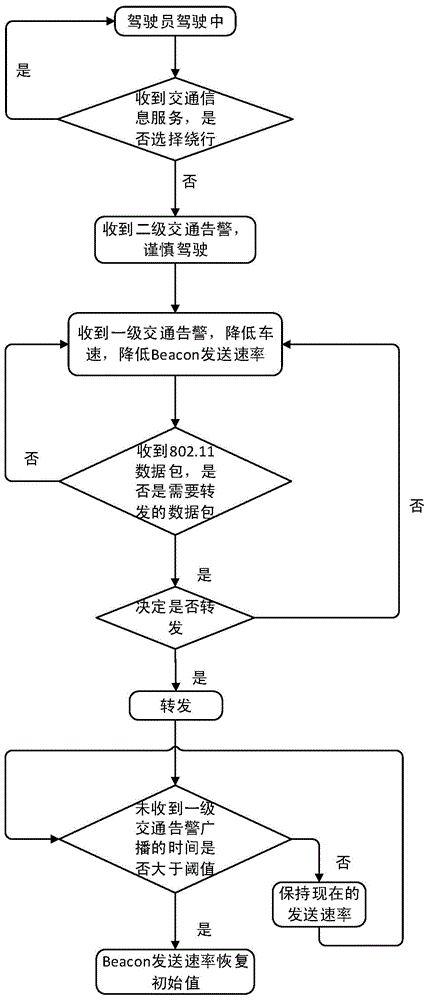Safety message broadcasting method in heterogeneous network environment for safe travel
A technology for heterogeneous networks and secure messaging, applied in the field of communications, can solve problems such as increased backoff time, channel congestion, and limited channel resources, and achieve the effects of small delay, large network bandwidth, and high power.
- Summary
- Abstract
- Description
- Claims
- Application Information
AI Technical Summary
Problems solved by technology
Method used
Image
Examples
Embodiment 1
[0038] A method for broadcasting safety messages in a heterogeneous network environment oriented to safe travel. In the eMBMS of the LTE system, the method divides service information into first-level traffic warning (priority 3) and second-level traffic warning according to service priority from high to low. Traffic warning (priority 2), traffic information service (priority 1) and eMBMS itself (priority 0), such as figure 1 As shown in FIG. 1 , the corresponding service information is broadcast according to the distance between the eNodeB (base station) and the location of the accident. The frequency of the first-level traffic warning is determined by the level of the first-level warning and the number and frequency of dangerous reporting vehicles per unit time. The content of the first-level traffic warning includes vehicle emergency news, unexpected traffic accidents, major traffic accidents, etc., with the highest frequency and the most timely update. The frequency of th...
Embodiment 2
[0056] When the density of vehicle nodes in the cell is high, a certain vehicle in the cell needs to broadcast a CCH emergency message. The vehicle broadcasts 802.11p data to ensure the timeliness of the broadcast within a short distance. The type broadcasts the first-level traffic warning information within the local area at a certain frequency, but the surrounding cells do not participate in eMBMS traffic safety broadcasting, and normal eMBMS services are not affected. Vehicles receiving 802.11p emergency messages within a range of 100-300 meters can broadcast and forward emergency messages at a lower frequency based on their own vehicle speed, and vehicles that receive broadcast forwarding further outside can forward emergency messages at a lower frequency or choose not to broadcast Forward. The outermost vehicles only receive emergency broadcasts from the eNodeB of the cell. In this way, problems such as channel congestion and broadcast storm caused by pure 802.11p networ...
PUM
 Login to View More
Login to View More Abstract
Description
Claims
Application Information
 Login to View More
Login to View More - R&D
- Intellectual Property
- Life Sciences
- Materials
- Tech Scout
- Unparalleled Data Quality
- Higher Quality Content
- 60% Fewer Hallucinations
Browse by: Latest US Patents, China's latest patents, Technical Efficacy Thesaurus, Application Domain, Technology Topic, Popular Technical Reports.
© 2025 PatSnap. All rights reserved.Legal|Privacy policy|Modern Slavery Act Transparency Statement|Sitemap|About US| Contact US: help@patsnap.com



